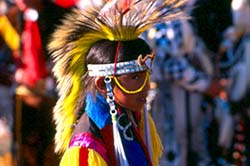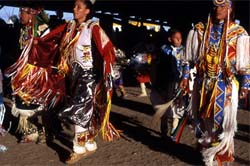Fort Peck Indian Reservation
Updated: August 5, 2020

A prosperous industrial park in Poplar is one of the largest employers in Montana. A variety of enterprises, including metal fabrication and production sewing, are housed in the park. Other industries, including an electronics manufacturer, flourish on the reservation. Farming, ranching, and oil extraction also contribute to the reservation economy. The Fort Peck Community College is located in Poplar. The college offers associate's degrees in the arts and sciences along with one-year certificates. There is a tribal law library on campus and a cultural center is planned.
Points of interest on the reservation are:
- Fort Peck Assiniboine and Sioux Culture Center and Museum
- Fort Peck
Events
- Red Bottom Celebration – third weekend of June
- Badlands Celebration – fourth weekend of June
- Wadopana Celebration – first weekend of August
- Turns Around Celebration – third weekend of August
- Fort Kipp Celebration – fourth weekend of August
- Poplar Indian Days – first weekend of September
The Fort Peck Reservation is the third largest reservation in the state. The Fort Peck Assiniboine have much of the same history as the Fort Belknap tribe, except the band twice separated from the northern band, who remained north in Canada to hunt buffalo on the Great Plains. The powerful Sioux Nation is made up of seven bands or "council fires." All of the bands share a common heritage. The seven bands evolved into three distinct language groups: the Dakotas, the Nakotas, and the Lakotas.

The Sioux on the Fort Peck Reservation are members of the middle band, the Nakotas. They were outstanding warriors, fighting not only hostile tribes, but also white intruders and the troops that protected them. To the Sioux, fighting was in many ways like a game based on valor and bravery; they might simply touch an enemy, representing a kill, and let him live. The Sioux, like many other tribes, migrated from Canada and Minnesota.
The tribe gave up much of their homeland to the government in a controversial treaty and moved west. The Sioux then occupied much of the Dakotas, eastern Montana, Wyoming, and Nebraska. In exchange for the right to build the railroad across their land, the Sioux were promised the Powder River Country and part of the Black Hills. Before the ink was dry on the treaty, gold was discovered in the Black Hills. The "rush" was on, miners poured in, and the government tried to buy back the land. The Sioux felt betrayed.
For more information about the Fort Peck reservation contact:
Fort Peck Assiniboine and Sioux Tribes
P.O. Box 1027
Poplar, MT 59255
406-768-5155
VisitMT - Fort Peck Reservation
Updated: August 5, 2020

